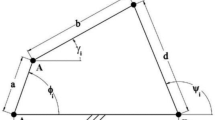Abstract
Many methods of performing mechanism synthesis rely on an attempt to redefine the dimensions of the system in such a way that a deviation from the desired behavior is minimized by the use of optimization methods. During the optimization process the optimizer may, however, suggest values of the dimensions, or design variables, that lead to infeasible designs, i.e. dimensions for which the mechanism cannot be assembled in one or more positions.
With the method proposed her, this problem is overcome by allowing the dimensions to vary during the motion of the system and subsequently minimizing the deviation of each variable dimension over a cycle. That is, for each time step the dimensions are allowed to change in order to obtain assembly as well as a desired kinematic behavior. This will lead to a variation of each dimension during a cycle of the mechanism, and this variation is the objective that is sought minimized. The minimization problem is solved using the optimality criterion.
Similar content being viewed by others
References
Erdman, A.G. and Sandor, G.N., Mechanism Design, Analysis and Synthesis, Prentice-Hall, Englewood Cliffs, NJ, 1991.
Haug, E.J. and Sohoni, V.N., ‘Design sensitivity analysis and optimization of kinematically driven systems’ in Computer Aided Analysis and Optimization of Mechanical System Dynamics, E.J. Haug (ed.), NATO ASI, Vol. F9, Springer-Verlag, Berlin, 1984, 499-554.
Hansen, M.R., ‘A general procedure for dimensional synthesis of mechanisms’, Mechanism Design and Synthesis 46, 1992, 67-71.
Bruns, T., ‘Design of planar, kinematic, rigid body mechanisms’ Master' thesis, University of Illinois at Urbana-Champaign, Urbana, IL, USA, 1992.
Hansen, J.M. and Tortorelli, D.A., ‘An efficient method for synthesis of mechanisms’ in Optimization of Mechanical Systems, IUTAM Symposium, Stuttgart, Germany, D. Beste and W. Schiehlen (eds), Kluwer Academic Publishers, Dordrecht, 1995, 129-138.
Hansen, M.R. and Hansen, J.M., ‘An efficient method for synthesis of planar multibody systems including shapes of bodies as design variables’, Multibody System Dynamics 2, 1998, 115-143.
Paradis, M.J. and Willmert, K.D, ‘Optimal mechanism design using the Gauss constrained method’, Journal of Mechanisms, Transmissions, and Automation in Design 105, 1983, 187-196
Minnaar, R.J., Tortorelli, D.A. and Snyman, J.A., ‘On non-assembly in the optimal dimensional synthesis of planar mechanisms’, Structural Optimization 21, 2001, 345-354.
Arora, J.S., Introduction to Optimum Design, McGraw-Hill, New York, 1989.
Nikravesh, P.E. and Gim, G., ‘Systematic construction of the equations of motion for multibody systems containing closed kinematic loops’, ASME Journal of Mechanical Design 115, 1993, 143-149.
Hansen, J.M., ‘Analysis and synthesis of mechanisms’ in Course on Structural Optimization, B. Esping (ed.), Östersund, Sweden, 1994, chap. 8.
Author information
Authors and Affiliations
Rights and permissions
About this article
Cite this article
Hansen, J.M. Synthesis of Mechanisms Using Time-Varying Dimensions. Multibody System Dynamics 7, 127–144 (2002). https://doi.org/10.1023/A:1015247821899
Issue Date:
DOI: https://doi.org/10.1023/A:1015247821899




